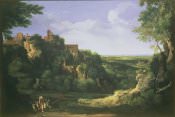Gaspard Dughet
Gaspard Dughet
Gaspard Dughet was the brother of the wife of Nicolas Poussin, to whom he was apprenticed. He took the name “Gaspard Poussin” and was often referred to simply as “Poussin” in the eighteenth century, which has led to some confusion. Dughet was born to a French father in Rome and lived there all his life, with only brief excursions to other Italian cities such as Florence and Naples. He chiefly painted landscapes, not only oils but also decorative schemes executed in true fresco, notably fourteen views for the Palazzo Muti-Bussi (1635–1637) and sixteen landscape scenes from the lives of Elijah and Elisha for San Martino ai Monti (ca. 1650). The demand for oils from Dughet’s hand followed on the success of his large wall paintings, which themselves remained the subject of major commissions throughout his life. Dughet’s style was formed on the severe foundations of Nicolas Poussin’s art combined with the compositions and motifs of Claude Lorrain, although his own paintings conspicuously lack Claude’s “golden light.” Like Claude, he is often celebrated as a master of topographical accuracy even though neither artist painted pictures that were wholly true to a particular scene, instead creating idealized landscapes made up of recognizable individual elements. Tivoli, near Rome, was a favorite area of exploration for Dughet. Unlike Claude, and unusually for any artist of the time, Dughet made a specialty of storm scenes and often made no attempt to “elevate” his landscapes by way of reference to the classical past. Indeed, some of his paintings were initially composed without any figures, which were sometimes added by other hands. Dughet’s compositional powers made him a favorite among British Grand Tour collectors, which in turn led to his having a great influence upon the course of British art and garden and landscape design. Richard Wilson is recorded as having made a memorable comparison between the two giants of seventeenth-century landscape: “Claude for air and Gaspard for composition and sentiment.”

